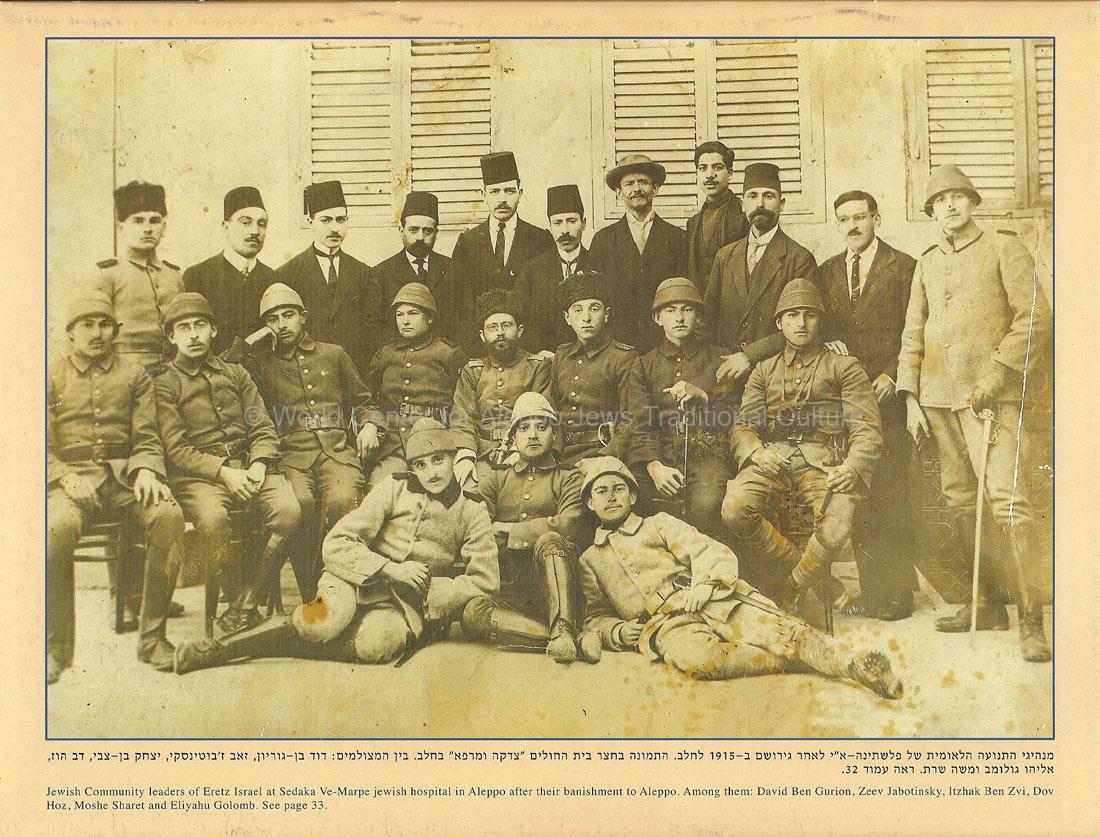Bulletin of the World Center for the Heritage of the Jewish Community of Aram Soba (Aleppo) Issue No. 10, Sivan 5757 – December 1998
During World War I, the Turks who ruled in the Land of Israel did not appreciate the national independence aspirations of the Jewish community leaders at that time. On September 4, 1917, they decided to act and expelled these leaders to Aleppo, Syria.
The Jewish community in Eretz Israel, specifically in Aleppo, received the expelled leaders warmly and with open arms. Among the community leaders at the time, Meir Nahmad stood out, serving as the “representative” of the Jewish Agency and working to organize the allocation of “certificates” for Jews in Aleppo, allowing them to reach Palestine – Eretz Israel – after its conquest by General Allenby in 1918.
This photograph depicts the expelled individuals from the Land of Israel during their reception at the “Tzedakah u’Marpe” hospital in Aleppo. The hospital was managed by Emmanuel Shaio (Abadi), who appears sixth from the left in the upper row of the photograph. The photo was taken in the hospital’s courtyard.
Perhaps it is due to the customs of Eretz Israel: the expelled individuals are seated, while the hosting Jews, the notables of Eretz Israel, stand behind them. Not all individuals in the photograph can be identified today. Emmanuel Kabasso and David Kabasso brought this photograph with them from Aleppo when they immigrated to the Land of Israel and later provided a copy of this photo to the President of the State of Israel, Yitzhak Ben-Zvi, who was also among the expelled. The Kabisso brothers identified some of the individuals in the photo as follows: Of the three seated in the front row, the Kabisso brothers identified only the person at the extreme left, Moshe Sharett. In the second row of seated individuals: Eliahu Golomb – third from the left, and next to him, fourth from the left – David Ben-Gurion, followed by Ze’ev Jabotinsky and Yitzhak Ben-Zvi. The other two seated individuals were not identified. In the upper row of standing individuals, which mostly consists of leaders of the Jewish community of Eretz Israel, the following individuals were identified: Meir Nahmad – fourth from the left, Emmanuel Shaio – sixth from the left, and next to him, wearing an English hat, Moshe Shalem, a Jewish Aleppan who held the position of consul for the United Kingdom. The Kabasso brothers recall that among the expelled individuals in the photograph was also Dov Hoz, but they were unable to locate him in the image.
Emmanuel Shaio, the director of the “Tzedakah u’Merefá” hospital, served the Jewish community of Eretz Israel with great dedication. During those years, a typhus epidemic broke out in the city at the end of World War I. Emmanuel treated the patients despite warnings that he might contract the disease, and indeed, he became infected and passed away. He left behind two children: a son named David Shaio and a daughter named Tara (Esther) Shaio. David worked as a teacher at the community school “Talmud Torah” and in the “Alliance” school (“All Israel is Friends”). A few years before the outbreak of World War II, the French, who ruled Syria at the time, granted scholarships to David Shaio and other Alliance teachers to study in Paris. David traveled with his Arab teacher colleagues, including Jamil Mahfouz, for an extended training course in Paris. Later, the Germans occupied Paris and the antisemitic Vichy government was established. The Germans and the Vichy French began hunting Jews in Paris to deport them to concentration camps. Jamil Mahfouz suggested to David that he declare himself Arab to save himself from the Nazis. David refused, declared his Jewish identity during a visit from the Germans at the institution where he was staying, was arrested, and sent to a concentration camp from which he did not return.
The daughter Tara Shaio married in Aleppo to someone from the Attia family, who served as the manager of the Banca di Roma in Aleppo. Their children now live in Panama City and are active leaders in the Jewish community of Panama and in supporting the State of Israel through the Bond Program and other aid efforts.
This photograph and the details presented here were provided by David, Baruch, and Emmanuel Kabasso – Tel Aviv.

